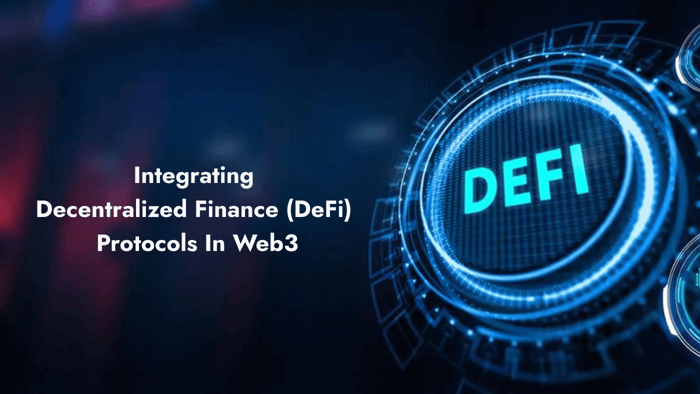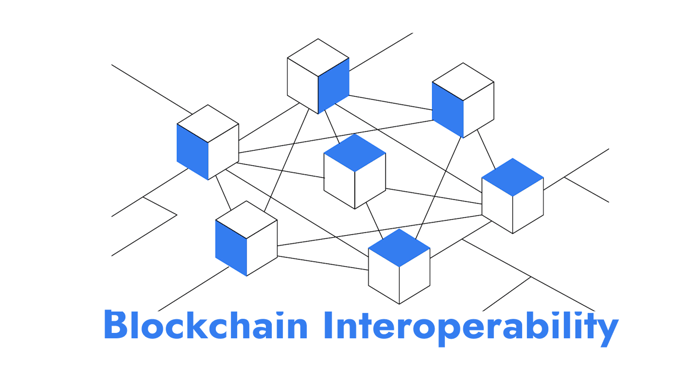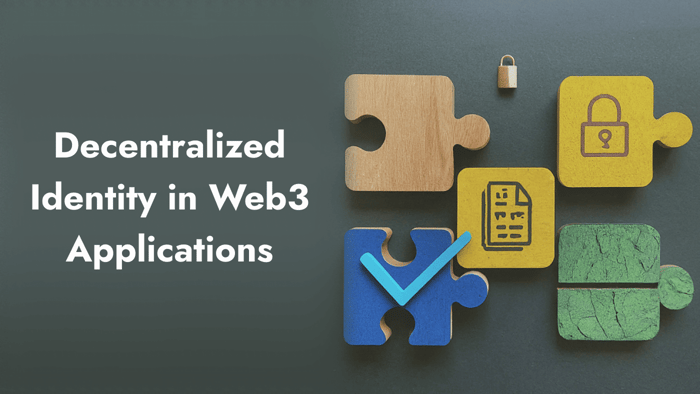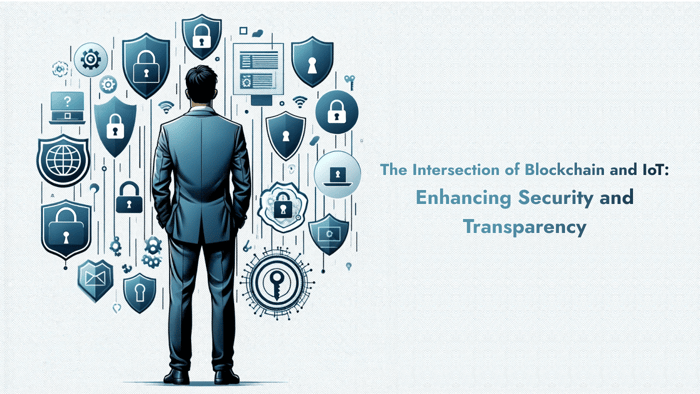Learn how to integrate Decentralized Finance(DeFi) protocols in Web3 development
Blockchain technology was initially created to support Bitcoin, the first decentralized cryptocurrency. However, it has now evolved far beyond its original purpose. Today, blockchain serves as the foundation for a multitude of applications, paving the way for Web3 and the decentralized finance (DeFi) ecosystem.
Web3 is the next phase of the internet's evolution, characterized by decentralized networks that aim to reduce reliance on traditional, centralized authorities and intermediaries. This new paradigm is built on blockchain technology, emphasizing user privacy, data ownership, and seamless interactions across the digital space. DeFi, a crucial element of Web3, extends these principles to the financial domain. It offers a range of financial services such as banking, lending, and trading that operate on decentralized networks. These services are permissionless, allowing anyone with an internet connection to participate without the need for traditional gatekeepers.
The relationship between Web3 and DeFi is symbiotic. They share core characteristics such as decentralization, interoperability, and non-custodial operations. These ensure that users retain control over their assets. Additionally, the programmable nature of blockchain technology enables the automation of financial services, making them more accessible and efficient. Together, Web3 and DeFi are not just technological advancements but a complete overhaul of the architecture of internet and financial services, promising a more inclusive and transparent digital future.
Understanding the Difference Between Web3 and DeFi
While Web3 and DeFi are intrinsically linked to the blockchain and share common ideals of decentralization and transparency, they serve distinct purposes and encompass different scopes within the digital ecosystem.
The Conflation of Web3 and DeFi
A common misconception arises when Web3 and DeFi are used interchangeably. This confusion stems partly from their shared foundation in blockchain technology and the fact that both represent significant shifts away from traditional centralized systems—be it in the realm of the internet (Web3) or finance (DeFi). However, understanding the unique objectives and applications of each is crucial for grasping the broader landscape of blockchain innovation.
Differentiating Web3 from DeFi
Web3 refers to the third generation of the internet, where decentralized networks and protocols replace centralized servers and authorities. It encompasses a wide range of applications beyond finance, including decentralized social media platforms, identity verification systems, and more, all built on blockchain technology. The hallmark of Web3 is its aim to give users control over their data, identities, and digital interactions, free from the oversight of central entities like tech giants and governments. This paradigm shift promises a more private, secure, and user-empowered online experience.
DeFi, on the other hand, is a subset of Web3 focusing specifically on the decentralization of financial services. It aims to recreate and improve upon the traditional financial system by removing intermediaries such as banks and institutions. Through smart contracts on blockchain platforms, DeFi enables anyone with an internet connection to access financial services such as lending, borrowing, and trading, without the need for a centralized authority. DeFi stands out for its emphasis on financial inclusion, transparency, and the creation of a global, open financial system.
While Web3 and DeFi may often be mentioned in the same breath due to their shared principles and underlying technology, it's important to recognize their distinctions. Web3 serves as the broad umbrella under which various decentralized applications (dApps) and services, including DeFi, reside. DeFi, in contrast, specifically applies blockchain's decentralization principles to finance, offering a revolutionary approach to accessing and interacting with financial services.
Benefits of Integrating DeFi Protocols in Web3 Development
Integrating Decentralized Finance (DeFi) protocols into Web3 development heralds a new era in the digital economy, offering profound benefits that align with the core principles of decentralization, transparency, and user empowerment. This integration not only propels the financial sector into the future but also transforms user interaction with digital assets and financial services. Here are some benefits of integrating DeFi protocols into Web3 development:
- Increased Transparency and Security: Unlike traditional financial systems, where transactions can be opaque and controlled by central entities, DeFi protocols operate on transparent ledgers. Every transaction is recorded on the blockchain, visible to anyone, which drastically reduces the possibility of fraud and corruption.
- Enhanced User Control and Ownership: DeFi protocols empower users with unprecedented control over their assets through non-custodial wallets. This means users retain full ownership and control of their digital assets, without the need for intermediaries like banks or financial institutions. The ability to directly interact with financial services via smart contracts not only enhances security but also democratizes access to financial systems, ensuring that anyone with an internet connection can participate in the global economy. This shift towards self-sovereignty represents a significant departure from traditional finance, where user funds and data can be subject to control and surveillance by third parties.
- Opportunities for Innovative Financial Products and Services: From automated yield farming and liquidity mining to tokenized assets and decentralized exchanges, DeFi leverages blockchain's programmability to create complex financial instruments accessible to anyone. This innovation extends beyond mere transactional capabilities, fostering a financial ecosystem where users can lend, borrow, trade, and invest in a transparent and secure environment. Moreover, the composability of DeFi protocols—often referred to as "money Legos"—allows developers to build on existing services and create new, interconnected financial products, further enriching the ecosystem.
In conclusion, the integration of DeFi protocols into Web3 development is not just an enhancement of the digital economy but a redefinition of it. By promoting transparency, security, and user autonomy, and by paving the way for innovative financial products, DeFi protocols are at the forefront of transforming how people interact with money and assets in the digital age. This integration promises a more inclusive, efficient, and secure financial future for all.
Key Components and Technologies of Web3
Ethereum has been pivotal in the rise of Web3 and DeFi, thanks to its implementation of smart contracts. Smart contracts are self-executing contracts with the terms of the agreement directly written into code. They run on the blockchain, making transactions traceable, transparent, and irreversible. Ethereum’s smart contract functionality has made it the leading platform for dApp(Decentralized Applications) development, including a wide array of DeFi applications such as decentralized exchanges (DEXs), lending platforms, and yield farming protocols. Its open-source nature and robust developer community have fostered an ecosystem where innovation flourishes.
Other Layer-1 Blockchains Supporting DeFi
While Ethereum has been a frontrunner, several other Layer-1 blockchains have emerged to support DeFi applications, each offering unique features and improvements over Ethereum, especially regarding scalability, transaction speed, and fees:
- Binance Smart Chain (BSC): Designed for high throughput, it supports smart contracts and boasts a robust ecosystem of dApps, including DeFi projects.
- Polkadot (DOT): Focuses on interoperability among blockchains, allowing otherwise independent blockchains to communicate and share information.
- Solana (SOL): Known for its incredibly high transaction speeds and low costs, making it attractive for DeFi applications that require quick settlement times.
- Cardano (ADA): Takes a research-driven approach to design and builds its blockchain to be more sustainable and scalable.
These alternatives to Ethereum are not only expanding the infrastructure for DeFi but are also contributing to a more diverse and resilient ecosystem.
Importance of Interoperability
Interoperability is a cornerstone of Web3’s vision, allowing different blockchain networks to communicate and share information seamlessly. This capability is vital for building a cohesive digital ecosystem where users can effortlessly interact with various services and platforms without being siloed into a single blockchain network. Interoperability enhances the user experience, broadens access to services, and encourages innovation by enabling developers to build cross-chain applications. Technologies and protocols such as Polkadot’s parachains, Cosmos’ Inter-Blockchain Communication (IBC) protocol, and the development of cross-chain bridges are leading the way in making interoperability a reality.
Practical Guide to Integrating DeFi Protocols
Integrating DeFi protocols into your Web3 application can significantly enhance its capabilities. Below is a step-by-step guide that walks you through this complex process:
Step 1: Protocol Architecture and Security
To build a successful Decentralized Finance (DeFi) application, it is important to start with defining the protocol architecture. This involves designing the core functionality of your application, including the structure of smart contracts, the role of tokens, funding mechanics, and profit models. In addition, prioritizing security is crucial for the success of your application. You should plan for multiple security audits throughout the development phase and adopt secure development lifecycles to ensure that your application is safe and secure for users.
Step 2: Development and Testing
Adopting an Agile development methodology can help you remain responsive to feedback and flexible enough to accommodate changes. In addition, building your application's architecture to support modular development will enable you to perform isolated unit testing for different components, which can help you identify and resolve issues more efficiently.
To ensure that your application is stable and secure, it is crucial to develop a comprehensive testing suite that includes functional, security, stress, and load testing. You can use test environments like Ganache for local blockchain simulation or public testnets like Ropsten for real-world testing conditions. By following these best practices, you can improve the quality of your software and minimize the likelihood of defects and vulnerabilities.
Step 3: Ongoing Optimization and Monitoring
By monitoring your application's performance, you can identify areas for ongoing optimization and improvement. This will allow you to stay ahead of the curve and remain competitive in the fast-paced world of DeFi.
Another important strategy is adaptability and evolution. To remain agile and responsive to user feedback and market changes, it's important to be ready to evolve your protocols as needed. This means staying up-to-date with industry trends and being willing to make changes to your protocols and smart contracts in response to changing market conditions.
DeFi is a high-risk environment, and it's critical that you continuously monitor for vulnerabilities and take steps to mitigate any potential security risks. This means staying up-to-date with the latest security best practices, regularly auditing your code, and making updates to your protocols and smart contracts as needed to ensure ongoing security and stability.
Integration with Other DeFis
One way to enhance your application's functionality is by exploring established protocols such as Aave, Compound, or Uniswap. By integrating with these protocols, you can leverage their features and capabilities, such as lending, borrowing, or trading.
Another way to increase your application's reach is by utilizing cross-chain interoperability protocols. These protocols allow for asset transfers across different blockchain networks, enabling users to interact with your application from various platforms. This can help expand your user base and improve the overall user experience.
Selecting the Right Tools and Technologies
If you're looking to develop smart contracts on the Ethereum blockchain, it's worth considering Solidity as the programming language of choice. To streamline the development and testing process, you may want to leverage frameworks like Truffle or Hardhat. When it comes to interacting with your Ethereum smart contracts, libraries such as Web3.js or Ethers.js can be incredibly helpful. Finally, it's important to prioritize security when building on the blockchain, so integrating security tools like MythX or Slither for static analysis and security scanning is highly recommended.
Security Best Practices and Considerations
It is essential to prioritize the security of smart contracts by subjecting them to thorough security audits carried out by reliable and reputable organizations. Additionally, developers should adopt a defensive programming approach to anticipate potential vulnerabilities and ensure the contracts are well protected from potential exploits. Adhering to the latest security guidelines and best practices from reputable resources like the ConsenSys Ethereum Smart Contract Best Practices can significantly enhance the security of smart contracts and protect them from potential threats.
Building the Team
To ensure a successful blockchain and finance project, it is important to assemble a team of experts with diversified skill sets. The team should consist of individuals who are proficient in blockchain development, smart contract development, and blockchain integrations. Additionally, security experts with vast experience in identifying and mitigating security risks should be included in the team. Finally, data analysts who are adept at leveraging data for optimization and insights should be part of the team. With such a team in place, you can be sure of a flawless execution of your blockchain and finance project.
Integrating DeFi protocols requires a thoughtful approach to balancing technical prowess with strategic planning. Focus on creating a modular, secure, and user-friendly application that leverages the collective strengths of established DeFi ecosystems. Always prioritize security and user experience to ensure the long-term success and adoption of your DeFi project.
Conclusion
As we conclude, it is a clarion call for developers, technologists, and visionaries to venture into the realm of DeFi integrations. The potential for creating dynamic, user-centric applications that leverage the full spectrum of DeFi's capabilities is immense and largely untapped. Experimentation is the key to innovation, and the DeFi space is ripe for those willing to explore and push boundaries.
For those ready to embark on this journey, the following resources can provide valuable knowledge and support:
- Ethereum.org's Developer Tools
- ConsenSys' Ethereum Developer Portal
- DeFi Pulse for Analytics and Rankings
- CryptoZombies for Solidity Learning
- Chainlink for Smart Contract Integrations
Additionally, communities such as Ethereum Stack Exchange and Solidity Forums are excellent for troubleshooting and connecting with other developers in the field.
The fusion of DeFi protocols into your Web3 projects is more than a strategic decision; it's an embrace of the future of finance. With the tools, resources, and communities available, the time is ripe to innovate and transform the digital landscape with DeFi.
Akava would love to help your organization adapt, evolve and innovate your modernization initiatives. If you’re looking to discuss, strategize or implement any of these processes, reach out to [email protected] and reference this post.





